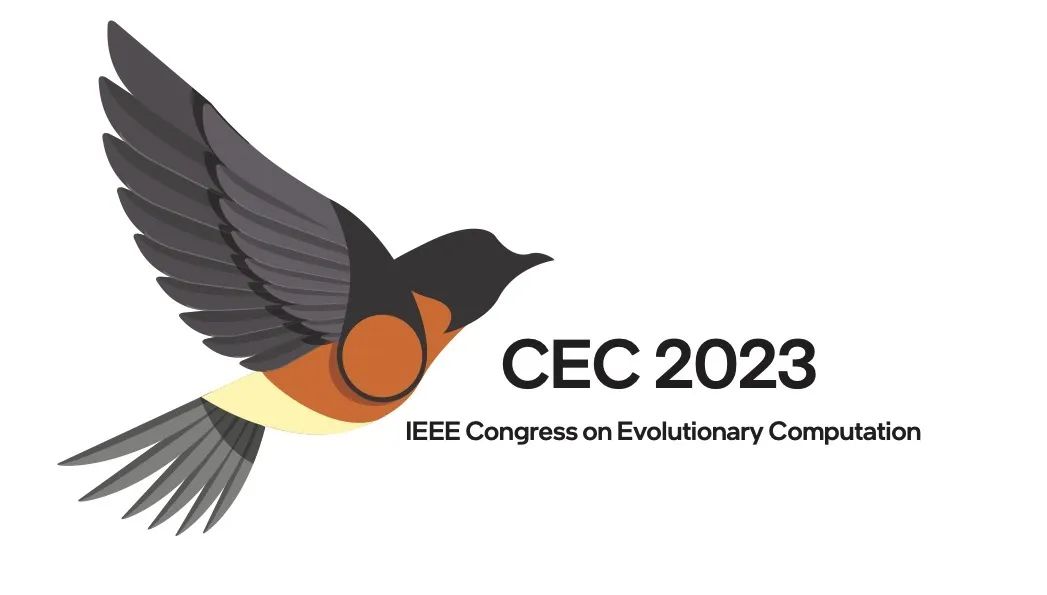原文链接可直达公众号
各位同仁们好,我们最近在2023年IEEE进化计算国际会议(IEEE CEC) 上组织了关于“进化计算机视觉和图像处理” 的Special Session,将接收所有关于进/演化计算算法应用于解决计算机视觉和图像处理问题的论文。
投稿截止日期为:2023年1月13日
投稿时请选择 CEC-SS: Special Session on Evolutionary Computer Vision and Image Processing (ECVIP)
欢迎各位专家学者学生们踊跃投稿! 谢谢!
详细信息如下:
Call for Papers:
Special Session on Evolutionary Computer Vision and Image Processing (ECVIP)
IEEE Congress on Evolutionary Computation (CEC) 2023
Swissôtel Chicago, USA, 3 July-5July 2023
https://2023.ieee-cec.org/

Overview:
Vision is the complex process of deriving meaning from what is seen. The fields of computer vision and image processing have tried to automate tasks that the human visual system can do, with the aim of gaining a high-level understanding of images and videos. Computer vision algorithms have been successfully applied to a large number of real-world problems ranging from remote sensing to medical image analysis, video surveillance, human-robot interaction, and computer-aided design. In turn, evolutionary computation methods have been shown to be more efficient than classical optimization approaches for discontinuous, non-differentiable, multimodal, and noisy problems. They have also demonstrated their ability as robust approaches to cope with the fundamental steps of the computer vision and image processing pipeline (e.g. restoration, segmentation, registration, or tracking). As a result of the convergence of the computer vision and evolutionary computation research fields, many research activities, including special sessions, have arisen in the last two decades.
Scope and Topics:
The proposed special session aims to bring together theories and applications of evolutionary computation techniques to computer vision and image processing problems. In this sense, this special session aims to be a meeting place for researchers in the fields of computer vision and/or evolutionary computation, with the aim of enriching both disciplines by means of the hybridization of state-of-the-art approaches from those domains.
Topics of interest include, but are not limited to:
New theories and methods in the application of evolutionary computation paradigms to computer vision, image analysis, and image processing problems.
- Evolutionary computation paradigms include
- genetic algorithms,
- genetic programming,
- evolutionary strategies,
- evolutionary programming,
- particle swarm optimization,
- ant colony optimization,
- differential evolution,
- evolutionary multi-objective algorithms,
- evolutionary transfer learning,
- and many others (e.g., neuroevolution, surrogate-assisted evolutionary algorithms).
- Potential applications in computer vision and image processing include
- image segmentation,
- image registration,
- visual scene analysis,
- image feature analysis,
- object detection,
- image classification,
- handwritten digit recognition,
- object tracking,
- face detection and recognition,
- texture image analysis,
- medical image analysis,
- gesture recognition,
- and robot vision, among many others.
Given the huge impact of deep learning in the computer vision community, especially from 2012, and the astonishing performance provided by deep learning algorithms in computer vision tasks, cross-fertilization of evolutionary computation and deep or shallow neural networks is especially encouraged. This will include research in
- transfer learning and domain adaptation
- meta-learning
- few-shot learning
- neural architecture search
- automated machine learning
- and any hybridization of evolutionary computation with
- multi-layer perceptrons,
- autoencoders,
- adversarial networks,
- convolutional neural networks,
- transformers
- and recurrent neural networks, among many other neural models
Hybridizations of evolutionary computation methods and other computational intelligence and machine learning techniques (e.g. fuzzy systems, reinforcement learning, and ensemble methods), applied to computer vision and image processing tasks are also encouraged.
Important dates:
- Paper Submission Deadline:13 Jan 2023
- Notification of Acceptance: TBA
- Final Paper Submission Deadline: TBA
Paper Submission:
Please follow the IEEE CEC203 Submission Website to prepare and submit the paper. Special session papers are treated the same as regular conference papers. Please choose the special session on "Evolutionary Computer Vision and Image Processing" when submitting the paper.
All papers accepted and presented at IEEECEC203 will be included in the conference proceedings published by IEEE Explore.
Important Note about the Review Process: Papers will be reviewed using a double-blind review process. After being reviewed, papers may receive an Accept, Reject, or Revise–and–Resubmit. For more submission information please visit https://2023.ieee-cec.org/paper-submission/
Organizers:
Harith Al-Sahaf
School of Engineering and Computer Science Victoria University of Wellington New Zealand
Email: Harith.Al-Sahaf@ecs.vuw.ac.nz
Homepage: https://al-sahaf.com/harith/
Ying Bi
School of Engineering and Computer Science Victoria University of Wellington New Zealand
Email: Ying.Bi@ecs.vuw.ac.nz
Homepage: https://yingbi92.github.io/homepage/
Pablo Mesejo
School of Computer Science
University of Granada Spain
Email: pmesejo@ugr.es
Homepage: https://www.ugr.es/~pmesejo/
Biography of the Organisers

Harith Al-Sahaf received the B.Sc. degree from Bagh-dad University, Baghdad, Iraq, in 2005, the master’s and Ph.D. degrees from the Victoria University of Wellington (VUW), Wellington, New Zealand, in 2010 and2017, respectively, all in computer science. In October 2016, he joined the School of Engineering and Computer Science, VUW as a Post-doctoral Research Fellow and as a full-time lecturer since September 2018. His current research interests include evolutionary computation, particularly genetic programming, computer vision, pattern recognition, evolutionary cybersecurity, machine learning, and feature manipulation, including feature detection, selection, extraction and construction, transfer learning, one-shot learning, and image understanding. He is a member of the IEEE CIS ETTC Task Force on Evolutionary Computer Vision and Image Processing, the IEEE CIS ETTC Task Force on Evolutionary Computation for Feature Selection and Construction, the IEEE CIS ISATC Task Force on Evolutionary Deep Learning and Applications, and the IEEE CIS ISATC Intelligent Systems for Cybersecurity.

Ying Bi received the B.Sc.degree in 2013 from Wuhan Polytechnic University, Hubei, China, the M.Sc. degree in 2016 from Shenzhen University, Shenzhen, China, and the PhD degree in 2020 from Victoria University of Wellington (VUW), New Zealand. Her research focuses mainly on computer vision, image analysis, machine learning, evolutionary computation, classification, feature learning, and transfer learning. She has published an authored book and over 40 papers in fully refereed journals and conferences in computer vision and evolutionary computation. She has been serving as an organizing committee member of IEEE CEC 2019 and Australasian AI 2018, a guest editor of the special issue on evolutionary and memetic algorithms for computer vision and image processing in the journal of Memetic Computing, an organizer of a workshop in IEEE ICDM 2021, a special session in IEEE SSCI 2021 and a special session in IDEAL 2021, and a program committee member of over ten international conferences including IJCAI, GECCO, IEEE WCCI/CEC, IEEE SSCI, and Australian AI. She was co-chair poster session at IEEE CEC 2019. She is serving as a reviewer of over ten international journals including all major journals related to EC. She is a member of IEEE, IEEE CIS, ACM SIGEVO, and the IEEE CIS ETTC Task Force on Evolutionary Computation for Feature Selection and Construction.

Pablo Mesejo is an Associate Professor at the Department of Computer Science and Artificial Intelligence (DECSAI) of the University of Granada (UGR, Spain). His main research topic is the analysis and design of machine learning, computer vision, and computational intelligence methods able to solve image analysis problems, mainly related to the biomedical domain. He has tackled numerous challenging problems, e.g. the automatic segmentation of anatomical structures in biomedical images (Ph.D. at the University of Parma, Italy, performed as a Marie Curie Early Stage Researcher, 2010-13), the classification of gastrointestinal lesions from endoscopic videos (postdoc at University of Auvergne, France, in a research lab belonging to CNRS, 2013-14), the estimation of biophysical parameters from fMRI signals (postdoc at Inria, France, 2014-16), and the integration of deep learning into probabilistic generative models for visual and audio recognition in human-robot interaction (starting researcher position at Inria, 2016-18). He joined the UGR in April 2018 as a Marie Curie Experienced Researcher. It is worth mentioning that Marie Curie Standard Individual Fellowships are highly competitive research grants that present a 13.10% success rate (in the H2020-MSCA-IF-2016 call). In turn, the UGR is one of the top institutions in computer science and engineering (ranked 1st in Spain and 101-150 in the world according to the Academic Ranking of World Universities 2020). His Marie Curie proposal (Skeleton-ID) specifically dealt with the application of soft computing and computer vision techniques for the comparison of radiographs in forensic identification. He is co-founder, partner and chief AI officer of Panacea Cooperative Research (a newly-created SME, and UGR spin-off, focused on finding intelligent solutions to solve unmet biomedical needs). He is also the vice-chair of the IEEE Computational Intelligence Society (CIS) Task Force on Evolutionary Computer Vision and Image Processing, member of the IEEE CIS Task Force on Evolutionary Deep Learning and Applications, and member of the Andalusian Research Institute on Data Science and Computational Intelligence (DaSCI).